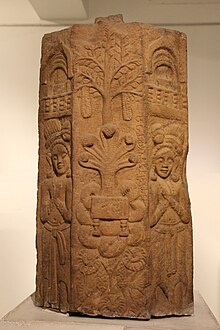Pauni
Pauni पौनि/पवनी | |
|---|---|
town | |
 Pauni पौनि/पवनी Location in Maharashtra, India | |
| Coordinates: 20°47′N 79°38′E / 20.78°N 79.63°ECoordinates: 20°47′N 79°38′E / 20.78°N 79.63°E | |
| Country | |
| State | Maharashtra |
| District | Bhandara |
| Government | |
| • Type | Municipal Council |
| Area | |
| • Total | 9 km2 (3 sq mi) |
| Elevation | 226 m (741 ft) |
| Population (2011) | |
| • Total | 12,821 |
| • Density | 1,400/km2 (3,700/sq mi) |
| Languages | |
| • Official | Marathi |
| Time zone | UTC+5:30 (IST) |
| PIN | 441910 |
| Vehicle registration | MH-36 |
| Nearest Railway Station | Pauni Road |
Pauni (पौनि or पवनी) is a town and a Municipal Council in Bhandara district in the Indian state of Maharashtra. Now it has National Highway NH-247. Pauni is also known as Kashi of Vidarbha due to its wide swath of temples.
Geography[]
Pauni is located at 20°47′N 79°38′E / 20.78°N 79.63°E.[1] It has an average elevation of 226 metres (741 feet). The town is surrounded on three sides by a moat and earthen rampart, and the fourth side by the Wainganga River. The main language of Pauni is Marathi, the regional language of the state of Maharashtra. Pauni is surrounded by Umred-Karhandla wildlife sanctuary, famous for tigers and other wild animals.

Introduction[]
Pauni (Pauni derived from the name of king "Pavan") is situated on the bank of river Wainganga known as South Ganga. It is a center of market and trade for the surrounding smaller villages and connects the smaller villages to cities like Nagpur, Chandrapur, Bhandara and Gondhia. In ancient times, Pauni was famous for the handloom textile industry. It is also a place of pilgrimage and boasts of many temples, schools, a high school and a science college.
History and Archaeology[]
Pauni is an ancient city, surrounded by a rampart and moat, the latter partly preserved. The remains of historical monuments are scattered all over the town. The city wall, atop the rampart, is partly preserved and dates to the seventeenth-eighteenth centuries.
Archaeological sites[]
The excavations at Pauni have shown that the area was a center of Buddhism from the Maurya[4] and Satavahana times, and coins of the early Satavahana ruler Satakarni I were discovered in connection with archaeological finds.[5] One of the excavated stupas, the Suleman Tekri stupa, had a diameter of 41.6 meters, larger than the main stupa at Sanchi.[5][6]
Jagannath Tekri Stupa. 20°47′01″N 79°38′09″E / 20.7835°N 79.6357°E There is an earthen mound to the south of Pauni, outside the fort-wall on the bank of the Balasamudra water body. A temple to Jagananath is built on the mound. Nagpur University has carried out archeological excavations around the Jagannath temple in 1969. These excavations unearthed the remains of a large stupa of the early historic period.[7] The stupa has a diameter of 38.1 meters and seems to have been worshipped from the 3rd century BCE to the 3rd century CE, undergoing several waves of enlargements and renovations.[8] The excavations revealed also a number of carved pillars, some on the site, and other pieces now in the National Museum of India and the Chhatrapati Shivaji Maharaj Vastu Sangrahalaya. A number of the pieces of this railing carry Brahmi inscriptions.[9] Four gateways seemingly rather similar to those of Bharhut were also erected.[8] The majority of the inscriptions record donations to the stupa, but one inscription mentions Mucalinda, the earliest reference to this deity in India.[10]

Pauni sculptures on railing pillar, 1st century BCE. Prince of Wales museum ref.78.91.[3]

Pauni sculptures on railing pillar.

Pauni sculptures on railing pillar, 1st century BCE. Prince of Wales museum ref.78.91.[3]

Railing pillar, Pauni, 1st century BCE. Prince of Wales museum ref.78.91.[3]

Pauni sculptures on railing pillar.

Pauni Carved medallion on coping.

Suleman Tekri Stupa. A second stupa was excavated by Nagpur University near the village of Chandakapur, about 600 meters south of Jagannath Tekri.[6][11] The Suleman Tekri stupa has a diameter of 41.6 meters, larger than the main stupa at Sanchi, and is dated to circa the 1st century BCE, with extensions down to the 2nd century CE.[5][6] Although monumental, no sculptures or decorations were found from this stupa, suggesting a severe, unadorned, design.[6] Coins of Satakarni were found in association with the stupa.[6] Coins of the Western Satraps were also found.[6]
Hardolal Tekri. This is a mound outside the town. A large megalith stone was found here, inscribed in the early historic period with the name of the ruler Bhagadatta.[12] The stone is now in the collections of the Nagpur Central Museum.[13] This mound was not a stupa.[6]
Coins and inscriptions[]

Coins were found belonging to the Satavahanas and the Western Satraps (Rudrasimha).[14][15][16] These Satavahana coins, among them coins of the early Satavahana king Satakarni, were found at the two stupa sites, confirming that ancient Vidarbha was part of the Satavahana Empire (1st century BCE - 2nd century CE).[17][18]
A few dozen donative inscriptions in the Brahmi script have been found at the site of Pauni, in a style similar to the inscriptions of Bharhut and Sanchi.[19]









